Dorothy Napangardi was a groundbreaking Australian artist
Dorothy was right at the forefront of the contemporary Australian Aboriginal art movement. Along with Emily Kngwarreye, Dorothy Napangardi is recognised internationally as one of Australia's foremost artists.
In April 2020, a major retrospective exhibition of Dorothy's work is opening at Japingka Gallery in Fremantle, Western Australia, with the exhibition also presented online.
Coincidentally, this retrospective is opening at a similar time to the retrospective exhibition of Emily Kngwarreye's work in New York.
This article provides information about Dorothy Napangardi's life and career, and introduces the 2020 retrospective exhibition.
Quick Facts About Dorothy Napangardi
Who is Dorothy Napangardi?
Dorothy Napangardi was a well known Australian Indigenous artist.
When was the artist Dorothy Napangardi born?
Dorothy was born into a family who lived in the Tanami Desert. As there were no official records her date of birth, it is estimated to be around 1950. Dorothy died in 2013.
What part of Australia is Dorothy Napangardi from?
Region: Tanami Desert, Central Australia
Significant Country: Mina Mina
What languages did she speak?
Warlpiri, Pintupi and English
Why is she famous?
Dorothy Napangardi is regarded internationally as one of the most important artists Australia has produced. Her highly innovative style provided significant artistic leadership for artists within the contemporary Aboriginal art movement.
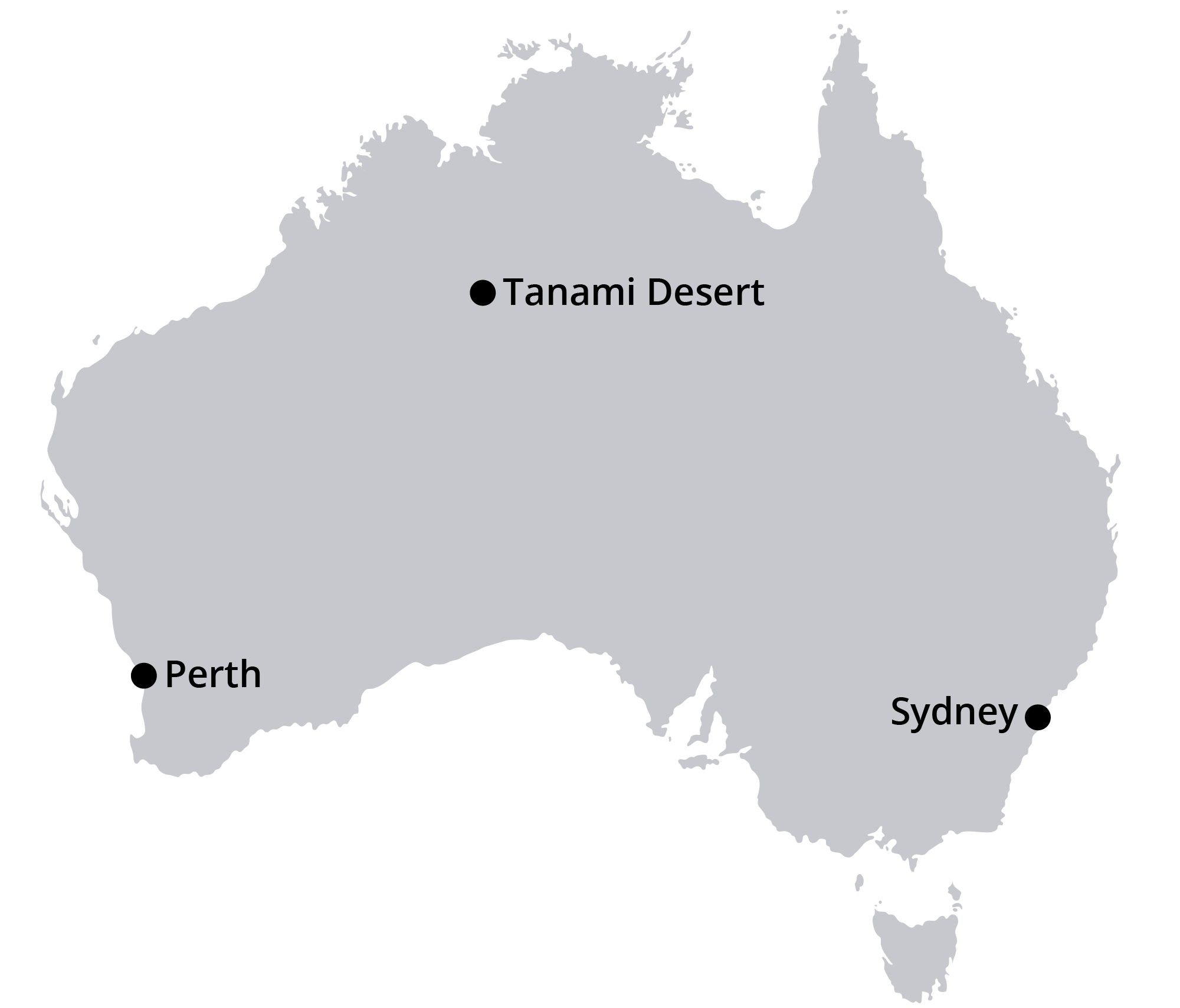
Quick Links
2020 Dorothy Napangardi Retrospective Exhibition
Japingka Gallery, Fremantle
Dorothy Napangardi Retrospective
The art and life of Dorothy Napangardi
Online Exhibition Now
Japingka Gallery
47 High Street Fremantle WA 6160
Perth, Western Australia
Dorothy Napangardi (1952- 2013) retrospective exhibition of the artist’s work leading to her major Mina Mina paintings with their beautiful minimalist effect.
This retrospective exhibition for Dorothy Napangardi (1952- 2013) shows the artist’s journey towards the refined style of the later Mina Mina paintings that established her career as an outstanding artist. Thirty-six paintings and eleven limited edition prints will be exhibited and available for sale.
The earliest work dates back to 1997 where we see the first aspects of the Mina Mina story painted between 1998 and 2001. From these early compositions, we see the structural elements that are transformed into large visions of the Mina Mina ceremonial site. The artist develops and reworks the subject in paintings spanning the years 2003 to 2009. In 2002-2003 the artist’s work was presented at the Museum of Contemporary Art Sydney in an exhibition titled Dancing Up Country.
This new exhibition honours the life and art of Dorothy Napangardi. The first such exhibition was held at the Seattle Art Museum in 2018. This exhibition is presented with the support of Roslyn Premont of Gallery Gondwana, whose long association and promotion of Dorothy’s artwork have given so much to this story and to this tribute exhibition.
Interview with Ian Plunkett
Ian is a Director of Japingka Gallery. The Retrospective Exhibition came about after a long association between Japingka, Dorothy Napangardi and her Manager and close friend, Roslyn Premont. Here Ian describes how the exhibition came together.
Aboriginal Arts Association
I've known Roslyn Premont for over 25 years, and we've been close friends. We were foundation directors of the Aboriginal Arts Association, which was the first organisation set up to ensure fair and ethical treatment for artists. We had a major meeting in Alice Springs with NGOs, artists and art centres who all came together to decide on Terms and Conditions. That's where Roslyn and I became friends as co-directors on the Board.
At that time Roslyn was working with a lot of different artists because she was based in Alice Springs with her own Gallery Gondwana. It was a highly respected gallery. One of the artists she was working with was Dorothy Napangardi, and we bought her work there. Her early paintings were very different from what we know of her work today. I'd see Roslyn on and off over the years, we've kept in touch and remained good friends.
The Loss of One of The Greats
We were sad to hear of Dorothy's tragic passing in a car accident in 2013. An exhibition of some of Dorothy's work was already arranged and that went ahead just after she passed away.
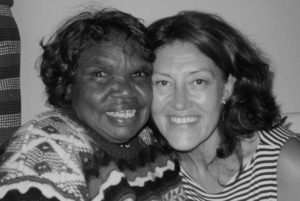
I've been seeing Roslyn over the years at art fairs in Alice and in Darwin.
Each time we met, I'd be reminded that Dorothy was easily one of the greats of the Indigenous fine art movement.
Roslyn was her a very close friend and her agent for so many years. I knew that it would take time before an exhibition could be considered. Ros had a wonderful personal collection of Dorothy's work. A lot of it had never seen the light of day.
A few years after Dorothy passed away, I mentioned to Ros that maybe it was time to have a retrospective to show some of Dorothy's finest works and expose her work to a whole new audience.
Introducing A New Audience
We talked about it and we both liked the idea, but it still wasn't the right time. It's only been in the last year or two that Roslyn agreed. She said, "Yes, I think you're right. Now's the time for people to be able to see her work again."
Roslyn very kindly gave us carte blanche to go through her private collection and select whatever we wanted. It is the best collection of work by Dorothy Napangardi in the world. They are stunning paintings. It was a real privilege to be able to do that.
Artistic Career Reviewed
What we are trying to do is document Dorothy's career because when Dorothy first started out she painted very differently. At that time she was painting bush bananas which were colourful, popular paintings. At the end of her career, she was painting the Mina Mina paintings and taking a whole new approach.
Eventually everything fell into place. Two years ago I had the chance to go to Alice Springs and go through the collection with Roslyn and select whatever I liked. It was fantastic. I was blown away to have that opportunity because I've not seen such a large body of high quality, unseen museum-quality work.
It is significant because Dorothy was one of the recognised greats of the Indigenous fine art movement. Like lots of things, if you're not painting and exhibiting, you disappear a little bit in the public consciousness. I'm aware that there'll be a lot of people out there who don't know about Dorothy Napangardi, whereas when she was working and painting, she had a high profile.
Timeless Works
Nowadays, less people know about Dorothy's work, which is a shame because her works are timeless. They are beautiful. They are great aerial views and maps of the women's ceremonial areas around Mina Mina. But they're more than that.
They have a zen-like quality, the composition, the feeling of timelessness, space, and the general structure in them. You can lose yourself in front of one of her paintings for hours. They're just gorgeous. I don't know anything else like her work.
In the exhibition, you will see a progression from the very early days with Dorothy's colourful bush banana paintings, right through as her career developed and her style changed. This style change was brought about mostly by her trips with Ros and some of her countrywomen to the ceremonial grounds out Mina Mina. That experience changed the way she painted and the way she saw her country. It was a cathartic moment where suddenly it came to her and her painting style changed forever.
National & International Recognition
The country trips were inspirational for her, and it transformed her career.
She was always a successful artist, but once she started painting these monumental landscape paintings of Mina Mina, it just transformed the way she was perceived. She became highly recognised.
Her works are in the National Gallery, State galleries and all major collections. Her major works are selling for tens of thousands of dollars, and yes, she became one of the recognised greats in Australia and internationally.
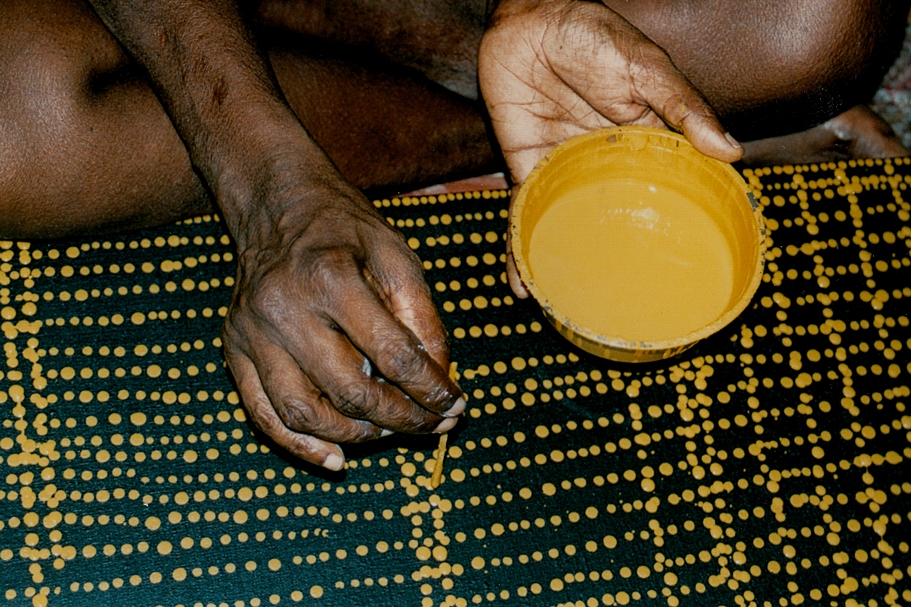
The Book
Dorothy Napangardi's Manager and long time friend, Roslyn Premont discusses the writing of a book to celebrate the life and art of Dorothy Napangardi.
The Time After Loss
I couldn't have written this book for the first five years after Dorothy departed. We didn't even look at any paintings, just out of respect.
When a person passes in Aboriginal culture, they become what they call Kumanjayi. You don't say their name, and you don't hold onto anything of theirs. You don't show photographs, and you don't show their paintings. The more important the person, the longer the period.
So five years was a very respectful time for such a thing. For five years, I just kept everything back. The other thing was that I just couldn't, just personally. Every time I thought about it or looked her work, I cried. So there was no point. I just kept everything rolled up, and that was it.
The Writing of The Book
I started writing the book when David Wroth from Japingka was visiting Alice Springs. We talked about doing something and I thought, "Well, I've got all of these paintings, I'll do something." At first I thought of doing a catalogue for the show. I started pulling everything out. All the memories started flooding back through the photos and through my notes. I thought the inner story of Napangardi deserves to be told. So that's why I made it into a book. It's now eighty-eight pages. The first part being the honouring, the exhibition, the survey retrospective that we're doing with Japingka and later in Belgium. The second part of the book is an insider's glimpse into her life.
Working on the book was very healing. I've loved every minute of it. There were some times when my fingers were flying over the keyboard and I couldn't stop. I'm thinking, "I'm going to be saying too much." But I just couldn't stop, it was like Dorothy was with me all the way.
And I thought "Okay, there's a story to be told, Napangardi. I'm going to give people a glimpse into you as a person, not just your artwork, but who you were."
Because it's coming from me, it's semi-autobiographical. It's a tale of two women and our connection.
At times, I would be doing something and I'd feel as if she was present. I'd feel like she was saying "Don't forget that" or "What about this?" or "What about that?" It became a joyful process.
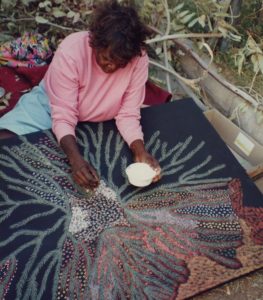
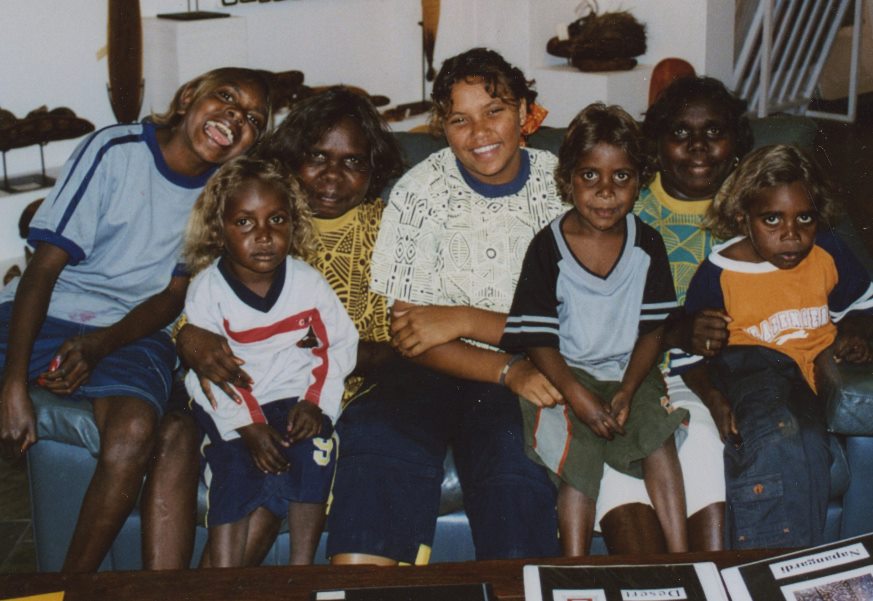
Book As Legacy For The Napangardi Family
I keep thinking that Napangardi wanted to pass this on to her children and her grandchildren. By doing this, I'm helping the process. I am doing that so that they can have this book. I've dedicated the third part of the book as a family album where I've got photographs of the children, photos of the kids during the road trips out bush.
They would have been grieving too much to have seen all of these pictures earlier. Now it's the right time for them to sit and remember and laugh together.
They can feel proud of who she was, the remarkable person that she was.
The book is going to be very informative to the public because it's going to give a deeper insight through lots of photographs and stories.
Media Contacts
To arrange an interview or photographs, please contact.
Japingka Directors:
Ian Plunkett
David Wroth
Opening Hours:
Mon - Fri: 10:00am to 5:30pm
Sat - Sun: 12:00pm to 5:00pm
Time Zone:
Time zone in Perth WA (GMT+8)
The Life of Dorothy Napangardi
Dorothy Napangardi's Manager and close friend, Roslyn Premont discusses the Dorothy's early years.
Birthplace in the Tanami Desert
The place where Dorothy grew up has an endless sky. It's in a very remote area of Australia. Even by our standards of desert country, it was a remote area.
It's close to the Great Salt Lake of Lake Mackay and it's called Mina Mina. Dorothy's family would move around that area during her early years.
It's sandhill country with clumps of forests, of desert oak trees. There's hardly anything on your horizon. If you swing around you could easily get confused about which direction you are going in. There are open spaces, but coming from the east, there are sandhills. It's actually difficult to get across those sandhills unless you know your way. That's by car. I suppose at the time by foot you'd work your way up and around easier.
These days, certainly by car, it's incredibly difficult to find a way across those sandhills to arrive at Mina Mina. It's in a flood plain, so when the rains come the claypans fill up and there is access to water there. As they recede and the earth cracks, you get these little indentations in the earth.
A lot of what you see in Dorothy's work is the cracked earth and indentations. These indentations are important because you need to be very observant to know where you can dig to find water.
There are water tunnels which go from one of those waterholes, those roundels, and lead to another, they're like little underground tunnels.
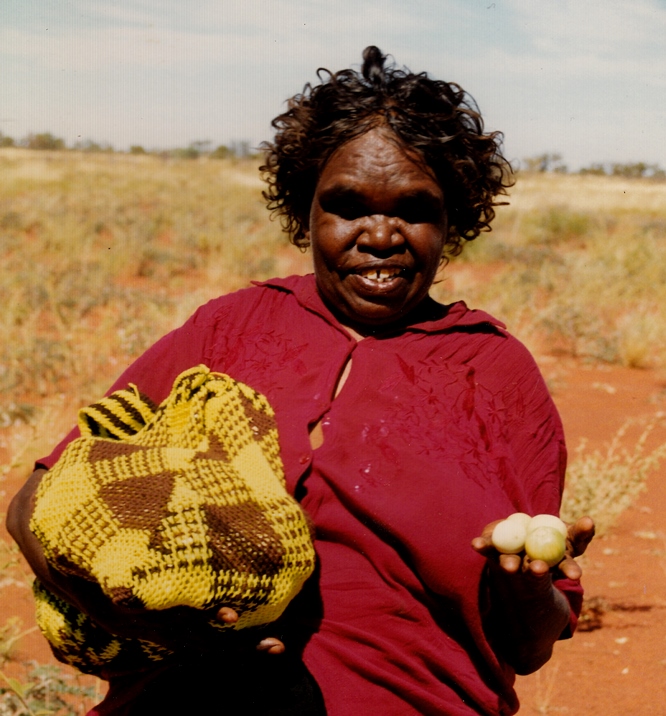
You can see the sandhills in her paintings, where the wind blows the sand. Her work is often very ephemeral. You know, it's similar work where the wind is blowing the sand or where there are little cracks in the earth. There's a lot of knowledge within those things.
She was interested in the tiniest little thing, as she was in the overall picture. There have been texts written about people who live outside of four walls. They talk about how these people see the world differently from those of us who are born within a house and its walls. Dorothy saw the world differently. She seems to have both an aerial aspect, a big view of the world, as well as the really tiny view of the details of the world.
Childhood
Dorothy was born in the bush and describes her childhood as a very happy one.
Her father was an extraordinary man, elegant and intelligent. I had the pleasure of meeting and getting to know him. He was deeply involved in ceremony and law. He had a lot of knowledge, as did his immediate family. Dorothy was brought up learning and knowing a lot about country in a very happy environment.
They lived well, primarily on lizards as there was no big game out that far, no kangaroos or emus. There was also a lot of bush foods, natural bush tucker. When I was there I would've starved in a day. I had no idea where I was or what I could do there. Everything looks so dry and sparse compared to what I'm used to. Dorthy would come back with abundant bush apples and berries and seeds. Her hunting skills were legendary.
Year of Her Birth
We don't know her exact year of birth because there were no records kept. Initially we wrote 1956 on everything because that's what is written on her social security papers. I realised from speaking to her and knowing her well, that it was probably earlier than that. We talked about how old she was when assimilation came and that gave me more of a clue.
Judy Watson Joins the Family
Dorothy's uncle died, and the family took in his daughter Judy Watson, Dorthy's cousin. Judy became another sister for Dorothy. She had several sisters and they giggled and laughed a lot. When I first met everyone, I was always surprised just how much people laughed and giggled and told stories. They're all storytellers.
The Men & Work
Dorothy's elders were important ceremonial men and they had culturall work to conduct. These were extremely respected and knowledgeable men within their own community. Dorothy used to tell a story about how her father was treated by the authorities. They made the men of her family dig holes and then fill them up again. Dorothy would tell me stories like that. She'd say, "Can you believe my father had to do this?" No wonder that he was sad.
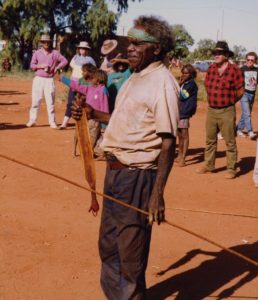
Describing The Person
Education
Dorothy was very clever because she had a lot of bush knowledge and she was very smart. You only had to play cards with her to realise she knew what was going on. Dorothy and her friend Rachel would roll their eyes in the air when I was playing cards with them because I was so slow. I always consider myself very good at maths and quite quick at mental arithmetic, but they were faster than I was. Despite all this talent, Dorothy was illiterate. This didn't seem to stop her when she wanted to achieve something.
Dorothy was good with thinking things through, and she was a good strategist. You could see that during her planning for trips away.
Alice Springs
Dorothy came to Alice Springs with her first husband, an older man she had been promised to. She'd come to Alice Springs because he wanted to come to Alice Springs. That was in the early eighties and then she made it her home. She never lived in Yuendumu. She might have visited her daughters because her daughters made Yuendumu more their home. They didn't have that pain associated with it and they married into that area. They'd come with her to Alice Springs, but they lived in Yuendumu. Dorothy would visit periodically.
Family Move to Yuendumu
Her family didn't choose to leave their land. It was the pastoralists and miners that were coming through and taking over the waterholes that forced them to leave.
They were herded off their land and taken into Yuendumu. They were desperately unhappy. Her father was very outraged and he couldn't settle into that new place. He would take the family at night and they would try and walk back. They would get as far as Mount Doreen and then they would be found and taken back to Yuendumu.
Never Dorothy's Place
Dorothy had no fond memories of Yuendumu and she barely ever lived there. As soon as outstations were started, the family moved to be closer to their homeland. Memories of Yuendumu were all about being forced there as a child and her father being very sad. Dorothy was about 10 or 11 years old when that happened. Prior to that she lived a happy bush life. She saw people draw in the sand when they were explaining something. She saw them put paint on their bodies for ceremonies. Those were the only ways drawing and painting happened in her childhood.
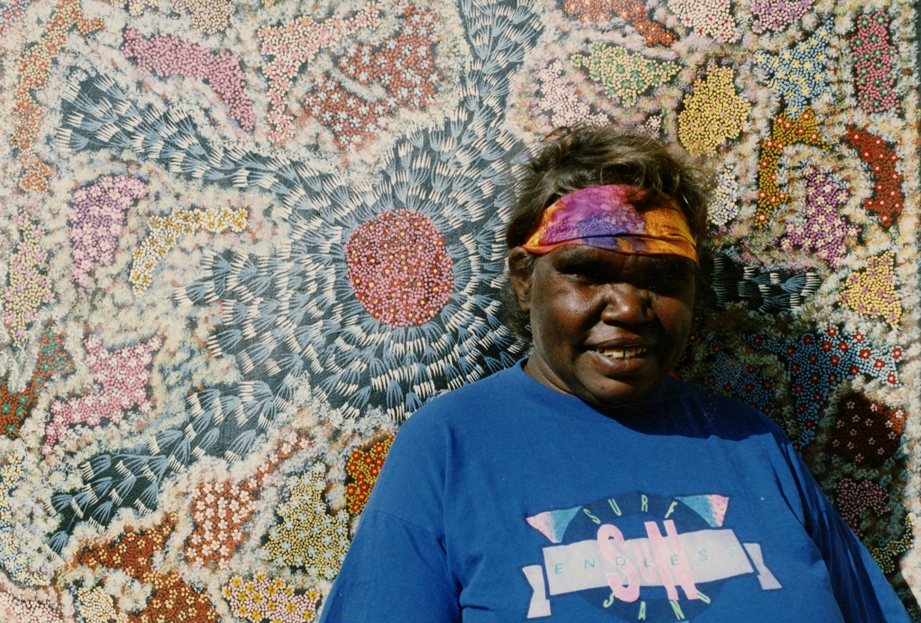
First Art Experience
In 1986 or 1987 Dorthy did a literacy course at the Institute of Aboriginal Development, IAD, along with a lot of her girlfriends, Warlpiri women. They had a simple art course there. I arrived in the beginning of 1987 in Alice Springs to manage the government gallery, which was called the Centre for Aboriginal Artists and Craftsmen. Dorothy came with a group of other women to the centre. They introduced me to Dorothy, and she started painting in 1987 at the Centre for Aboriginal Artists.
Love of Travel
Dorothy loved travelling. She was adventurous when it came to exploring places and trying new food. That is unusual for Indigenous people from the Central Desert. She loved trying new things.
She often travelled to Fiji. She got used to travelling from Alice Springs to Sydney and flying internationally by herself. Again that's very unusual for any Aboriginal person from remote communities to get on a plane and travel alone.
Shopping
Dorothy loved shopping. She took to shopping like she did hunting. She'd say, "you didn't see that jumper, but I saw it first so it's mine." You know, things like that. There was a bit of competition between us.
Sense of Humour
Dorothy had a dry sense of humour. She and her sisters would giggle when they got together. Dorothy was amused by quirky things that were weird or a bit unusual.
Hunting Expeditions
Dorothy loved hunting. Her most favourite thing was to go bush to go hunting. Whenever she had a weekend or any time out, she would organise a hunting trip.
If someone couldn't drive her, she would pay for a mini-bus to take her and her friends and family. They liked to see what was happening with the bush bananas, what berries were there, what animals were around.
Lizard Hunting
The thing that set Dorothy apart from anyone else when it came to hunting was her skills as a lizard hunter. She could sing songs that made perentie, that big monitor lizard, dopey and stop in its tracks. I wouldn't have believed it if I hadn't seen it. They would be running, and she'd sing "Ahhh," and they would stop and they'd swing side to side. Then she'd whack them over the head. There are photos of her with perentie lizard on her shoulders. Everyone knew her as a great hunter and gatherer. They would just say, "Great hunter, that Napangardi."
Powers of Observation
To be a hunter, you've got to be an observer. You've got to recognise the tracks and understand the cracks where creatures entered in the earth. She was just always looking, always observant, and she brought this into her painting.
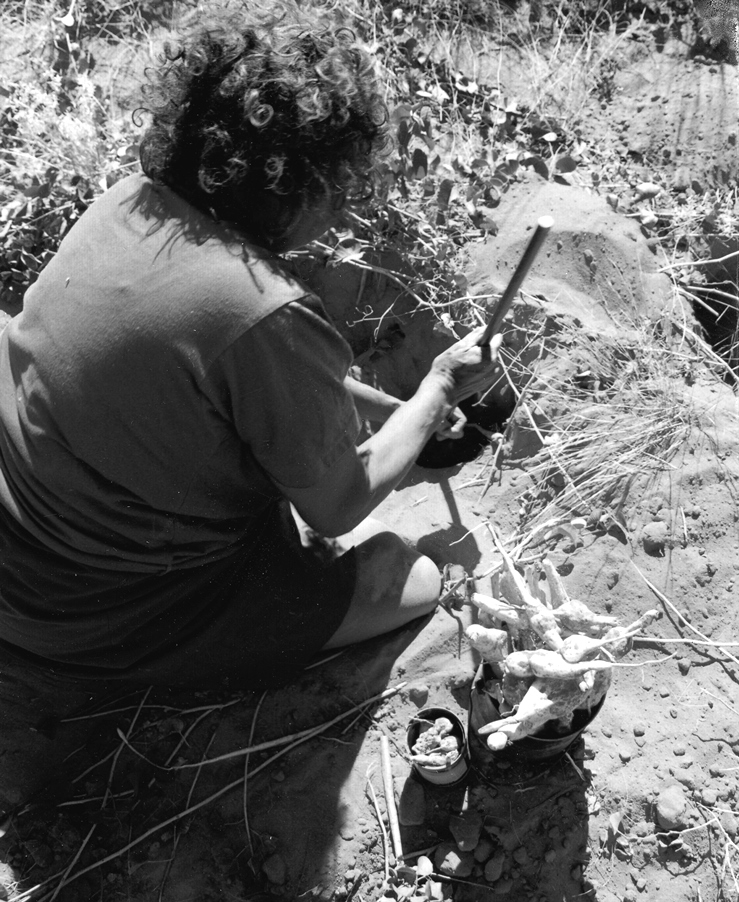
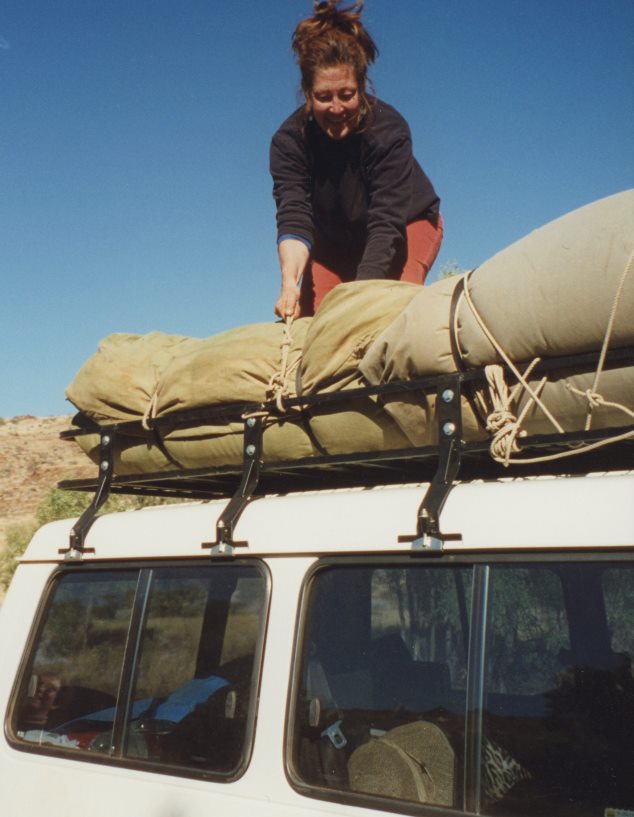
Saving For Trips
Dorothy had a savings box that we kept in the safe. I said, "Whatever money you put in that for your next trip, I'll match it. So when she'd finish a painting, she would work out what she had to give to the family and what she would keep. She always put away that trip money, that was non-negotiable.
She was a disciplined saver when she had a goal. She would work towards that goal and save and then she would hire vehicles and take everyone back to Mina Mina.
Planning for Trips
Dorothy knew there was a lot of money involved in hiring vehicles and the necessary equipment for travel to remote places. She would plan it all carefully. She approached it like a military general - right down to the last detail.
Health Issues
Dorothy had a major health challenge that she managed day-to-day. She was diabetic. This meant that she had to be careful with her diet. She never would have anything sweet.
Painting A Source of Pride
Dorothy was proud of her painting career. Her experience as an artist transformed her from a shy person to a very confident person with a sense of self-worth.
I used to tease her, "Once you were a queen, now you're an empress." She ran her own life. We were all her lackeys in the end. Doing this, doing that, saying this, saying that.
Recognition
It meant a lot to Dorothy that she was recognised by other designers and artists. She knew that a famous artist in America had purchased her work. She liked that.
Rest in Fiji
Dorothy fell in love with Fiji. It became her bolt hole. She lived in a village there and the local women were wonderful with her. She had a love affair there with a man who was gentle and very funny. She loved going and spending time in Fiji. It got her away because as much as she loved her family, there was sometimes a lot of pressure from the extended family.
This is a very common experience for Aboriginal artists who are earning money because there is a strong cultural tradition that things should be shared. At times when it just got too much she would say, "I need a break." She'd head off to Fiji. She called Fiji, "my island home". Dorothy had some wonderful friends in Fiji.
Challenges
It was a challenge to find the right balance when it came to supporting the extended family. Some of the young men were heavy drinkers, and it was a challenge when they put demands on her. They would come knocking at her door and making a lot of noise. She was sometimes evicted because of the people knocking and screaming outside trying to get in, asking for money. At times she found those demands and stresses exhausting.
The Telstra Award
Dorothy took a very pragmatic approach to the money issue. After she won the $40,000 Telstra Award she arranged to meet me to deal with it. She sat down in my office and said, "Okay, get out all these envelopes." She got me to write on all these envelopes. She told me, "You'll put this much in here, this much there,". Once I realised what she was doing, I said, "Dorothy you're giving it all away." She said, "The quicker, the better. If I don't have anyone else asking me, the better." So she gave it all away.
Sydney
Sometimes Dorothy liked to take time out in Sydney. I had a house there and we always kept a bedroom free for her. It was another place she could go to rest.
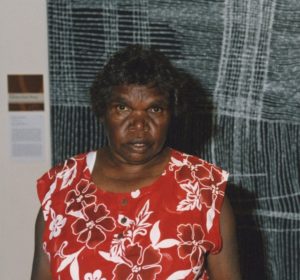
Family Connection
Dorothy loved her family. She had five girls, three of them were with her. The other two children lived with her extended family. The three girls who lived with her I knew very well. The youngest, Annette, I've known since she was a baby, She's been coming to the studio after school. I made sure she'd get to school. We also engaged a tutor to help the younger children with their school work.
Dorothy would say "I want my grandchildren to understand this. I want my grandchildren to know my story. I want the grandchildren to know the country." It was all about passing it on to grandchildren.

Community Farewells Dorothy
Dorothy died doing what she loved most, and that was coming back from a hunting day trip in 2013. So she spent her last day doing her favourite thing. They were coming back when she was involved in a terrible car accident.
Dorothy and I had just been to Sydney together. We were invited by the Italian designer Zegna because he put her design onto ties that were to be worn by famous people. We'd just attended a big fashion show in Sydney. We'd been treated like film stars. Dorothy had just finished a major carpet design for a Brisbane project. Her work was no longer only just about her paintings. Her work was extending out into the world and she was proud of that.
Just weeks before she died we were in Sydney for that Zegna show. We were sitting in a cocktail bar of a fabulous hotel overlooking Sydney.
We toasted our glasses and she said, "You know, for two old women we're doing alright."
Quick Links
The Artistic Career of Dorothy Napangardi
From 1990 up until her death in 2013, Dorothy Napangardi worked closely with friend and Manager, Roslyn Premont. In this article Roslyn talks about how she came to be involved with Aboriginal art and how she met Dorothy.
Roslyn Premont - Australian Embassy In Paris
I'd arrived in Paris in 1978 to take up my position at the Australian Embassy. The embassy hosted the very first Desert Art exhibition. I think they called it Painting the Desert. It was in the reception area in the front foyer of the Australian embassy in Paris. This is a huge Harry Seidler building with big open spaces. I arrived and saw these paintings and I thought to myself, these are extraordinary. I loved them immediately.
I thought, why don't I know about this? What's happening? Why hadn't I seen these? Well, I was fascinated. The next year there was an Australia Day reception at the embassy. The French President's brother was the Head of the French Bank. He asked me to tell him about those paintings. I remember thinking at the time "You love them, I love them. I'm going to come back here one day and I'll sell them to you." That was in the back of my mind. I found out later that Robert and Janet Holmes à Court bought that whole exhibition.
I came back to Australia in 1983, I contacted the Department of Foreign Affairs and I said to them, look, I'm fluent French-speaking, and if you ever need someone to help out, I'll do it free of charge, week-ends, whatever. If ever you need someone to be picked up from the airport or help out in any way, I just want to get to know Aboriginal people.
I think I felt ashamed when I was in France because people would ask "tell me about Aboriginal people." I'd never met an Aboriginal person because I was born in Sydney in a suburb where it's very insular. Aboriginal culture just wasn't seen or talked about at school.
I became aware of this lack of knowledge, and I it really bothered me that I didn't know anything about Aboriginal people. I decided I was going to change that. My first engagement was when I was asked to accompany a group of Aboriginal people to New Caledonia to be their guide and interpreter. I became even more interested and eventually took the role in Alice Springs working at the government-run gallery there.
Roslyn and Dorothy Meet
I first met Dorothy in 1987. My first impression was that she was very shy. The other women were quite bold and vocal. They were all related in some way. One of them was her sister, Eunice Napangardi. They were all quite strong confident women. Dorothy seemed quite delicate. Initially she couldn't keep eye contact. She didn't know me. Everyone there was Warlpiri and so I assumed she was Warlpiri. Years later I said to her "Hey your Dad's some Pintupi. Aren't you Pintupi?" And she said, "All that Pintupi are Bush mob." From this I could tell she felt the Warlpiri women of the town were perhaps smarter in some way.
Her mother was Warlpiri, but her father was Pintupi. She was a bit overshadowed by the strong Warlpiri women. She had left Mina Mina when she was very young. She hadn't fully completed her right to paint that country as a fully initiated grown woman. She only had the children's knowledge, first-level knowledge. Her friend Eunice Napangardi gave her the right. She said, why didn't you just paint Bush Banana and Bush Plum? All Napangardi have the rights to that. That's your country.
Dorothy was inspired by Eunice's approach to painting. Initially Dorothy painted these very delicate, colourful, spatial compositions of the Bush Banana and the Bush Plum in flower and early fruit.
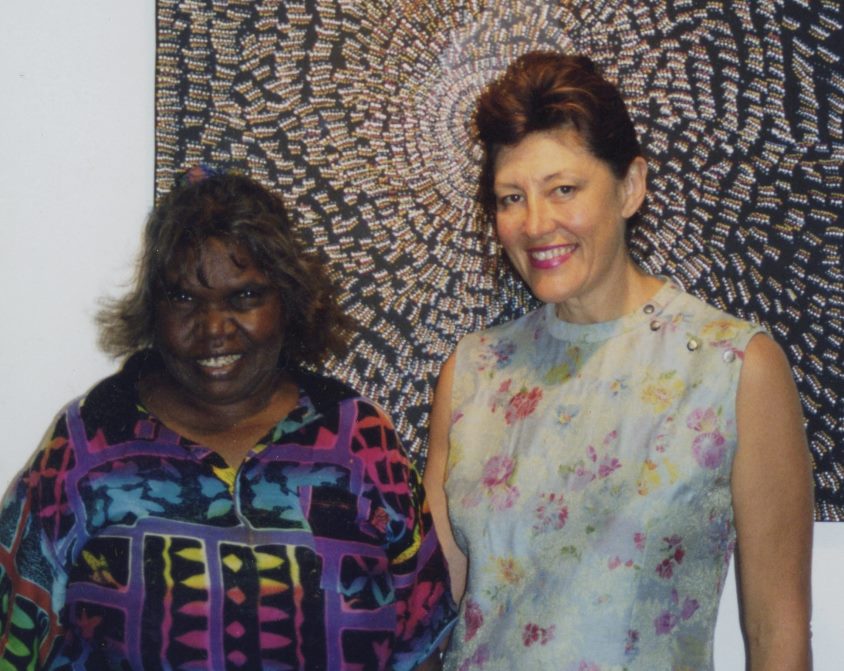
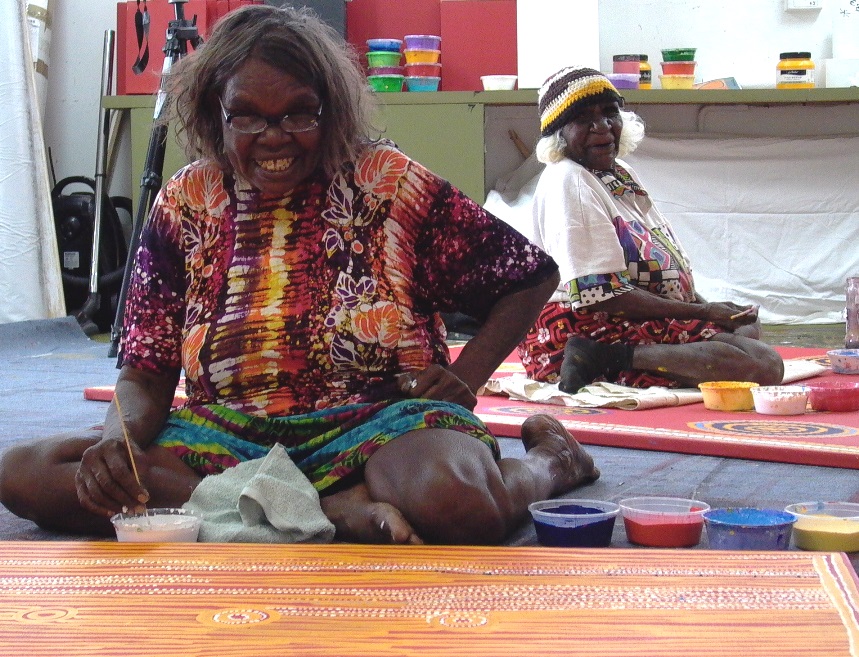
The Government Gallery in Alice Springs
I ran the government gallery in Alice Springs for over three years, and during that time Dorothy got to know me. They all got to know me. We did a lot of things together. I'd come from Sydney, but not long from four years in Paris. I wasn't interested in meeting other white people in suburban Alice Springs. I was much more interested in learning about the bush and Aboriginal beliefs and country. I spent a lot of my week-ends with the ladies doing what they liked most, and that was going out bush.
I'd drive, and we'd go out and forage for things and have picnics. Dorothy got to know me over those three years socially and through the Centre professionally. Eventually, I opened my own gallery, Gondwana.
Dorothy liked to tell the story of how I said to her, "Hey Napangardi, why don't you paint for us?" She rather liked that I invited her to paint for the gallery. She was proud to be recognised. That's how our professional relationship got started.
Gallery Gondwana Representing Dorothy
So from mid-1990 when I opened Gondwana, Dorothy was one of the first artists that I represented exclusively. We developed a really close relationship. Thinking back, we spent more time than most married couples would spend together. Every day she would be there with me. When we opened the studio five years later, she was there every day. She'd be popping into the gallery to bring her paintings in. That was when a close friendship developed.
Most of the time Dorothy called me Napururrla, which was my skin name. I was given this name when I first arrived. It's not unusual for people to be given names when you work there because you need to fit into their life. Occasionally when she wanted to be intimate, she'd say Ros-lynn. Dorothy liked to joke about me, "that one's too busy talking on her mobile phone. She misses shopping. Sometimes she doesn't see things". Or "You blind one, Napururrla, can't you see that kangaroo off in the distance? You must be blind."
Instant Appeal of Dorothy's Work
I never doubted that the journey with Dorothy as an artist would be something special. As far back as the early '90s I saw how people instantly reacted to her work. Dorothy would bring works into the gallery and they'd be leaning against the wall waiting to be hung. Sometimes the painting would even be behind another painting waiting to be processed. People would still find it. I was amazed at how quickly people found them. They were drawn to her work.
Career Turning Points
In 1991 Dorothy won Best Painting in Western Media category at the Telstra Awards with one of those Bush Plum paintings. Then she won the Northern Territory Art Award. The United States exhibitions were also successful.
Dorothy's Point of Difference
The thing that probably sets Dorothy apart from a lot of people was that she was passionate. She was committed to her practice, she loved to paint.
She was very proud of what she did, and she was very loyal.
Loyalty & Artistic Partnership
During all those initial years, Dorothy didn't go around trying to sell her work at different prices. She was very loyal to the gallery. That meant that as a team, we could really work together. She trusted my judgement and my friendship. I took her on a lot of trips. I took her to visit my family.
Whenever we had things to do like on those first years of the Art Trade association, I'd take her along with other artists as well. I like to show her my life, my upbringing. I tried to give her some insight into that, as she was showing me her upbringing, insight into her life. So we just became good friends and we had a harmonious relationship.
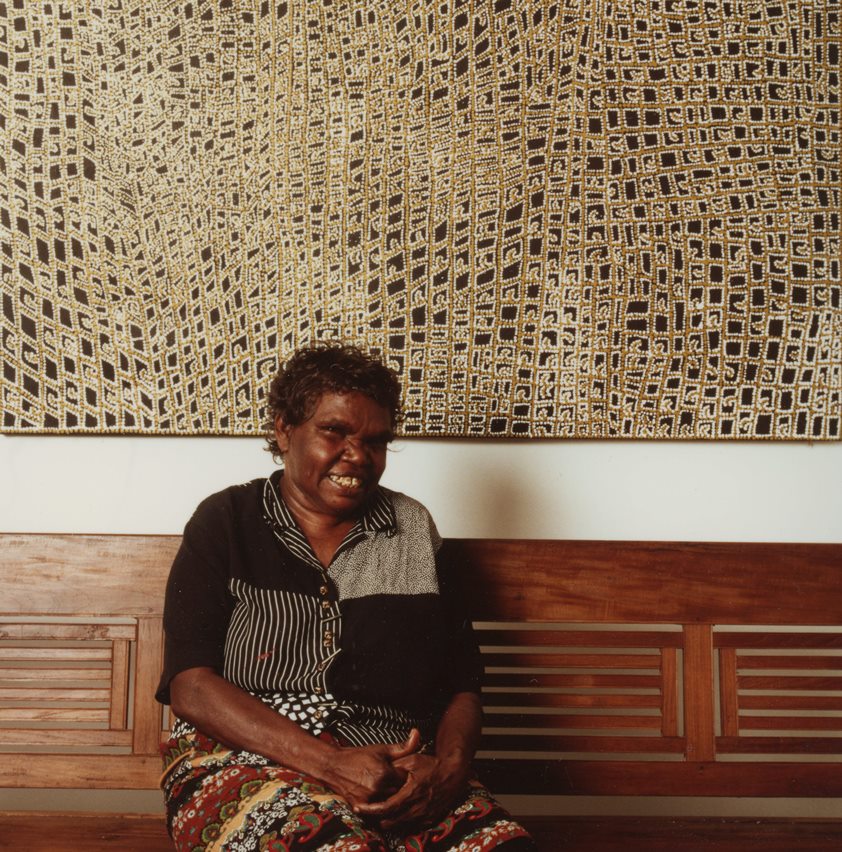
She was quite shy, but she became more and more confident and outspoken even though to new people she would appear shy. She was very sure about what she wanted always. She never hesitated to state what she wanted and I appreciated that.
Dorothy Work Process
An Original Artist
As an artist Dorothy was very original. She didn't follow what everyone else was doing. Her family members or artists would come in when we had the studio from 1995 onwards. They would come in and they'd say to her, "But where are the U-shapes? Where are the circles?" Dorothy would say, Yes, yes, yes," and "Yeah, they're coming. They're coming," and she'd smile and she'd talk to them. After they'd leave, she rolled her eyes and keep going.
The Studio
Prior to 1995, she would paint from home and then bring her work in. We would supply the canvas and the paint to get the right quality. We opened the studio because of Dorothy. She desperately needed a quiet place to paint. She was always saying, "Look, it's too noisy. There are dogs around, and there are more children. I need quiet."
A premises became available behind the gallery, we took it and initially it was just so Dorothy had her space. We also had more storage, but it was for her. She would often be there before we arrived. The studio assistant, Jeffrey would make her a cup of tea, she would settle in, she'd put her music on. She loved her country and western and gospel music.
Spirituality
Dorothy attended a Baptist church. She integrated Christian beliefs with her own traditional spiritual knowledge. She just kind of didn't see much difference. Occasionally she'd listen to recordings of family singing about her country. She liked to listen to those song cycles.
Dorothy liked her own space. She liked to think. She liked to mull things over and be in her quiet space.
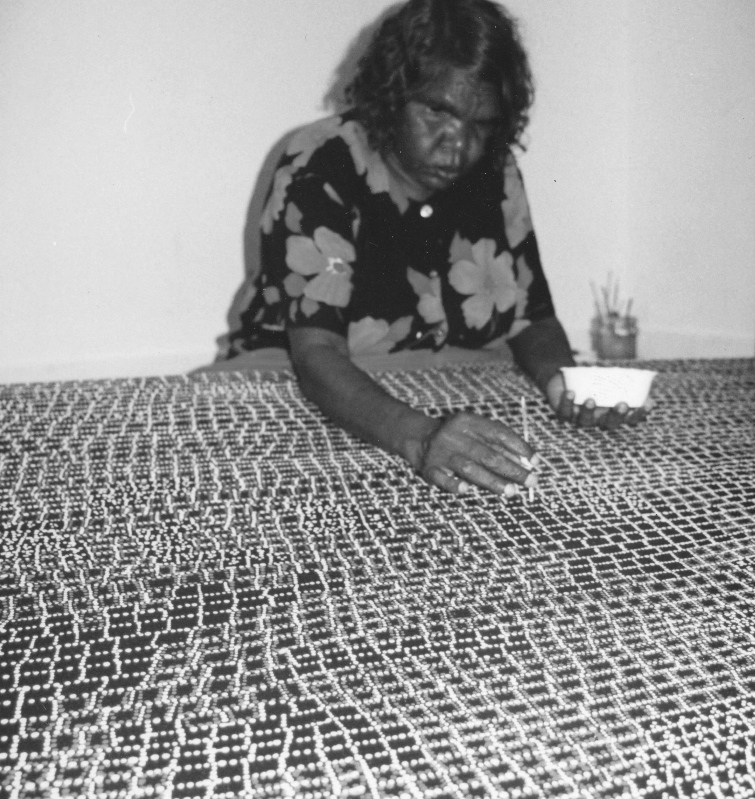
The Spirits of Mina Mina
I learnt some more about Dorothy's spiritual beliefs when we went out to Mina Mina for her ceremony. That was a very important time for her because she had all her aunties there, she was going through the next stage of her knowledge. As the sun was setting, as the ceremony finished and all of us women drivers thought that we'd just be camping nearby. The women said no. They insisted that we get in the car and drive at night. We were terrified because we couldn't see where we were going. There were termite mounds. The danger of piercing our tyres was enormous, but they made us drive away.
Years later she said to me, "You didn't see those spirits did you? You just didn't see them." I said, "What are you talking about?" She said, "They were standing right there. They were all around us, but you couldn't see them."
That was the reason we couldn't sleep at that sacred spot. We had to move on. We had to get away to sleep. It would have been very disrespectful to have slept there. At the time I was just thinking, what's going on? Why, why can't we just lie down? I'm tired, I've been driving a long time, but we couldn't do that. The women were very insistent.
They had a strong sense of connectedness and spiritual spiritual belief about where you were born. The spirit is your mother's stomach. When she first feels you in the tummy, they make a note on that spot because the spirit lives there in the land. She remained very connected to country and connected to her belief. Even though her work when we look at, might seem like pure abstraction, but it was always connected to country. She would never paint something that was outside all of her rights to paint. That would have been wrong. This is not just design, her work is imbued with spiritual knowledge.

Negative Space
When she started painting, she would have these negative spaces. She'd paint maybe the lines of the journey or some other element first, and she started to want to stop. She started to like the negative space, to want to just see it for what it was and not fill it in.
Black & White - The In and The Out
One time Dorothy came to me at home on a Sunday morning, and she said to me, "Black and white." I said, "What are you talking about? Do you want a cup of tea? What's going on?" And she said, "Black and white. I just want to do a black and white painting." So we went and opened up the studio so she could start.
We had a show going to the Hogarth Gallery in Sydney, it was right towards the end of sending the show off and then she finished this new work, she said, "Send this."
Everyone was looking at me, you know, looked up and said, "Is it finished? What?" And I said, "Look, if Dorothy says it's finished, it's finished." She wanted to present it, so we'll go and send it. That was already a big turning point. She had been watching these paintings in development and decided that she didn't want to fill the whole spaces in anymore. She wanted to leave space.
She was interested in what she always called, "The in and the out." She wanted people to feel as if they were travelling through her work, and not just looking at an image. She wanted to see how you could enter in, and how you could travel out again. So, "The in and out of it," was a phrase I heard a lot.
This move toward negative space and black and white started there. It came from the observation of her own work, but also from observation of the country, and her assertiveness of knowing that she had every right to paint what she wanted as a fully initiated woman, she could do what she wanted.

Career Development
Change In Her Work
Her work changed after a trip back to the country in 1999. We arranged a big country trip and it was the first time she went back to country with all her family. It was this big convoy that she'd planned and saved up to pay for. She was ready to move on to be given the next state of her knowledge about the country by her elders.
Around that time, she became more confident that she could paint anything to do with her country. She came back from that trip with lots of images in her mind. We were taking photographs on her behalf at that time. Often times she'd say, "Look at this, look at that," or she'd just be observing.
She used this sense of observation that she had about tracks and the skins of lizards and cracks in the earth and open sky and sandhills. All that came into her work which gave her a whole range of new topics to paint. Having the studio made a huge difference because it meant that she could work on a few different paintings at once if she wanted to, while she was watching a painting.
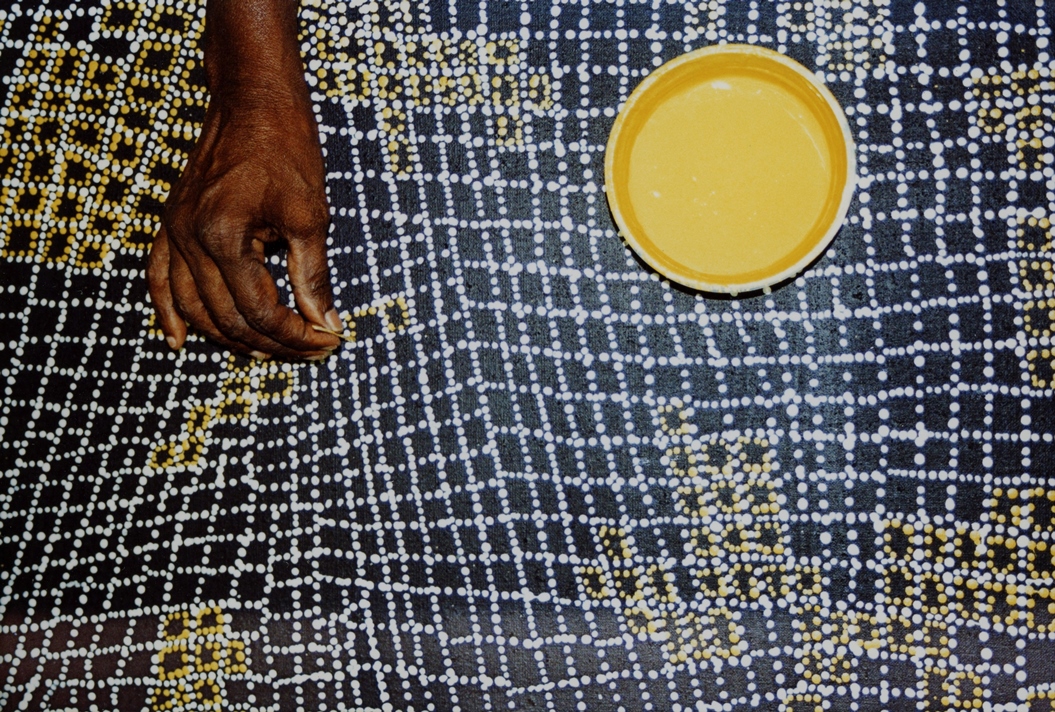
Developing Her Own Style
Dorothy was at the forefront of this type of approach to painting. She was the ground-breaker. She was the only one who was doing anything like this at the time.
If she had worked in a group, she would not have been able to do it either because there would've been too much peer pressure to have put those circles and U-shapes and all that in there. Instead she fostered her own space and working in isolation, she developed her own practice just how she wanted.
She talked a lot about her art. She just liked the push and the pull. She was always experimenting, and she was a conceptual artist in the sense that she did little drawings. She did sketches about what she wanted to achieve. She just didn't sit down there and dot, dot, dot, dot, dot. She would work on lots of little paintings when leading up to doing a big work.
She'd ask for small canvases and that's how we got all these little pre-stretched works, canvases that she'd have around so she could just pull them in, work on what she was thinking about. Then she'd decide what she liked and what she didn't like and how she wanted to perceive it, what she wanted to develop. That's how she worked on her larger pieces.
She knew ahead of time what she wanted to achieve. It wasn't just haphazard, it's not by chance these things happened. It was because she developed and worked to what she wanted.
We encouraged her. We didn't say, "Don't do that," or "Don't do this," because the bottom line was whatever she did, we couldn't hold onto. So why would we?
I'd tell people working with artists, "Don't make too many comments about what's good, what's bad," because you don't want someone doing something just because they want to please you. Let them express themselves. For two years, I refused to let anyone to make comments. We kept everything to ourselves while she did the art.
I learned that through working with Napangardi and through other people from the studio because over time, Dorothy brought in other people to the studio. So it became like a group. Some were close family members. You know, just a handful of amazing people often in the studio with her. However, on a daily basis it was just Dorothy.
Breakthrough Show
Dorothy's solo exhibition at the MCA was an important break through. It was amazing for her to see that, to have that acknowledgement. She grabbed my hand as we walked down the corridors towards it and said, "I feel like I'm walking through my life. I've got goosebumps."
Recognising The Need For Diversity
Earlier on when I'd taken her to one of those shows in Sydney at the Hogarth Gallery. They were very supportive of her work right from the beginning. She worked out early then that she had to have diversity in your work. She said, "I can't do two things the same," when she saw a whole gallery full of her paintings.
She was observing that some artists when she came in the gallery, were a bit like that. They just kind of had their style and that was it. But she had made up her mind that she wanted to have diversity in her work.
The MCA was a big stamp of approval for her. She'd just won the overall Telstra. So, she had won the Telstra three times, you know, but not the overall award winner. She won the overall category in 2001, and then the MCA had a show. All that was exciting for her.
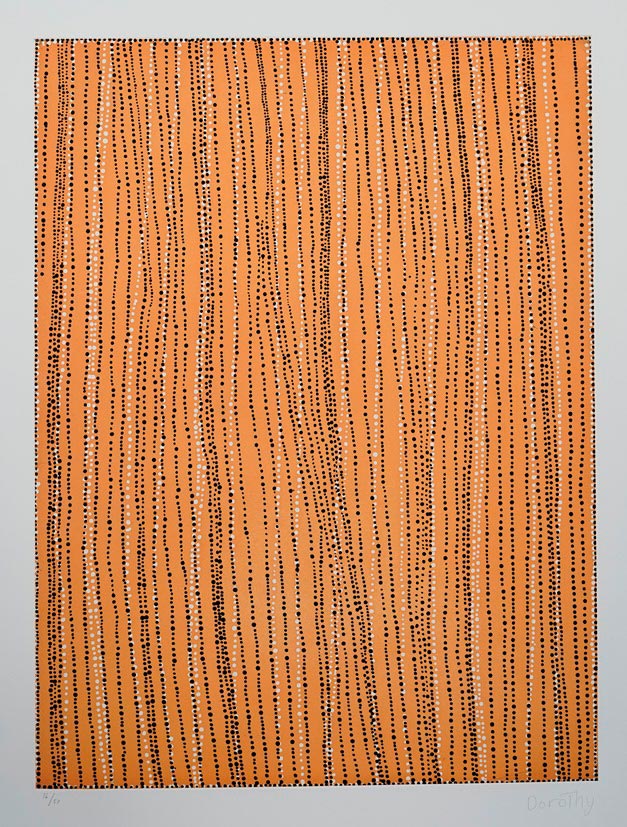
Print Making
Another big thing that Dorothy loved was printmaking. I suppose she had an intellectual approach to her work, that she loved printing etchings. She enjoyed printmaking enormously, and was always excited to go back and work with printmaking because she found it challenging. She liked the fact that she had to work. That excited her. It expanded the challenge.
Dr Christine Nicholls
Dr Christine Nicholls is a professor who is now at the Australian National University, ANU. She was great with Dorothy, because she's a fluent Warlpiri speaker. She interviewed her on many occasions and they got on very well. They became close friends. Dr Christine Nicholls was an important person as far as documenting her as a Warlpiri person and being an academic and art writer, she was an important person in Dorothy's life.
Seattle Collectors
Dorothy had meaningful relationships with several collectors that went beyond the collection of art. They were her personal friends and she loved their close attention to her work. She felt very safe.
One collector was telling her about one of her paintings he had in his lounge room," and he said, "You know what? I feel as if I'm entering in and I'm coming out of your work. I'm in and out." Dorothy pulled my hand and she leaned me over and she said, "That man knows my work."
You know, she loved that. She loved meeting people that she thought could actually appreciate what she was doing.
My Favourite Memory of Dorothy
I was going through the photos. There's countless photos of her and I sitting together in the studio. I'd be sitting with my head on her shoulder watching what she's doing. My favourite memory is just sitting with her.
The way she painted was so musical in its own way because she contacted physically: tu tu tu, tu tu tu. There was a real rhythm. She also had a stillness and self-assuredness in her presence.
Retrospective Exhibition
I'm very happy that Japingka has chosen to do a retrospective and were interested in showing work from all stages of her career. They were interested in the whole body of her work because both Ian and David are passionate about Dorothy's art. I know Dorothy would be honoured to have the show with Japingka, as I am on her behalf.
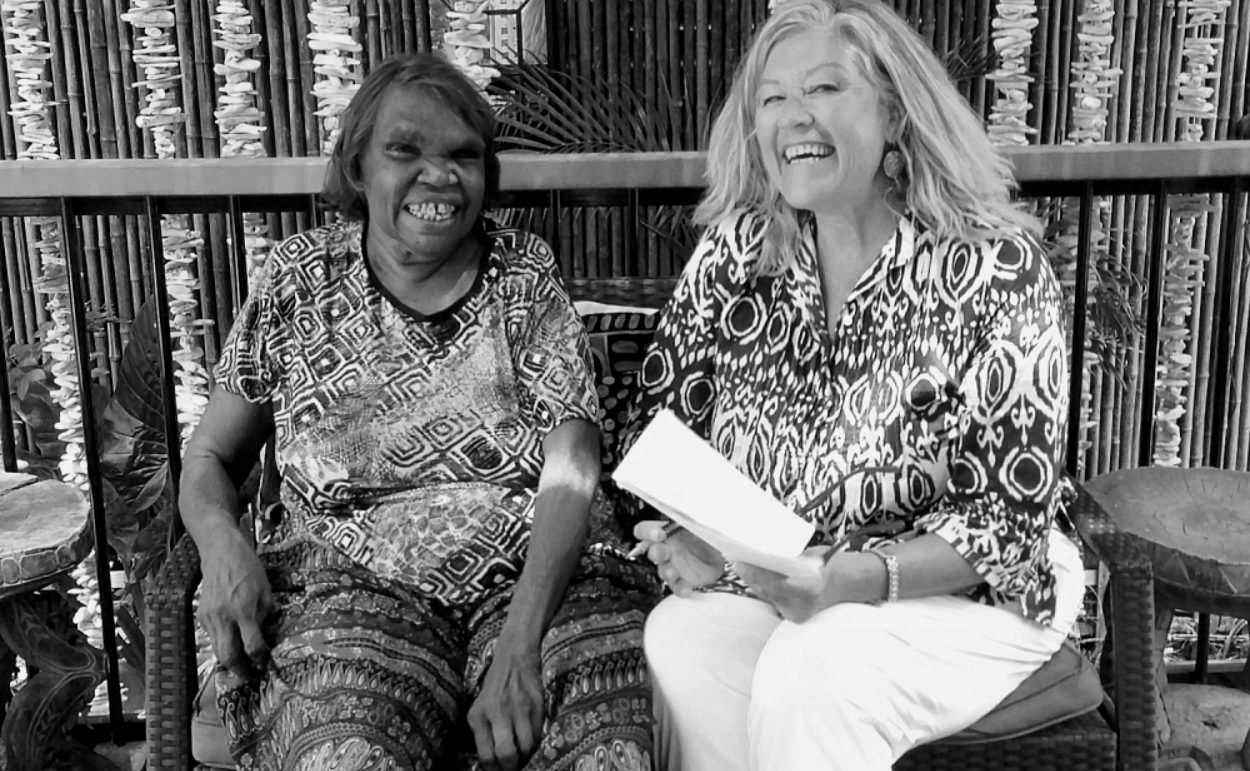
Mina Mina Ceremonial Site
Dorothy's close friend and Manager Roslyn Premont explains the importance of the Mina Mina ceremonial site.
Karntakurlangu is one of the most extensive and significant women's Jukurrpa (Dreamings) belonging to the Warlpiri. The works by Dorothy depict the ceremonial site of origin for the Jukurrpa known as Mina Mina. This is Dorothy's custodial country, located near Lake Mackay in the Tanami Desert, north west of Yuendumu in the Northern Territory.
During the creation era ancestral women of the Napangardi and Napanangka sub-section groups (aunt/niece relationship, in which knowledge is passed from one generation to another) gathered to perform the ceremonies and take-up ceremonial digging sticks (kuturu) that had emerged from the ground.
A large stand of Desert Oaks (Allocasuarina decaisneana) now grow where these digging sticks emerged from the ground. The Jukurrpa women then proceeded east transiting the vast expanse of Warlpiri tribal land, performing rituals of song and dance, creating the environment as it is today.
The women travel across the landscape, stopping to hunt, dance and sing. As each reconnects, both individually and together with their place, the travelling tracks converge and coalesce. It is here that we find the key to Warlpiri art - it is the journey that encompasses the creation and thereafter, the renewal of the country and one's connection to the land.
During ceremony, the women sing songs in short song cycles that contain the knowledge about that country. The graphics of the bodypaint and the words to a song are very important. They can't be changed in any way. They're passed down word by word from generation to generation. As they sing their song cycles they have someone, one of the women they now refer to as a policeman, who listens in and makes sure that it's word perfect. The ceremony is intended to regenerate and to acknowledge the country.
When Dorothy paints, she's painting that country, but the graphics are open. You're free to paint your country however you want as long as you're painting the country that belongs to you.
The site itself is a big claypan which of course holds water when it rains. It's a sacred site so you look after it. You don't sleep on it, and you don't go walking on it normally. You treat the surrounding areas with those desert oak trees very carefully.
Painting Names
Mina Mina is a Dreaming associated with women. It's called the Kartakurlangu. 'Karnta', meaning women, and 'kurlangu' meaning belonging to. So that's the main theme of Dorothy's story. If you look at the names of her paintings, you'll see this name repeated because that's the main Dreaming story she is retelling.
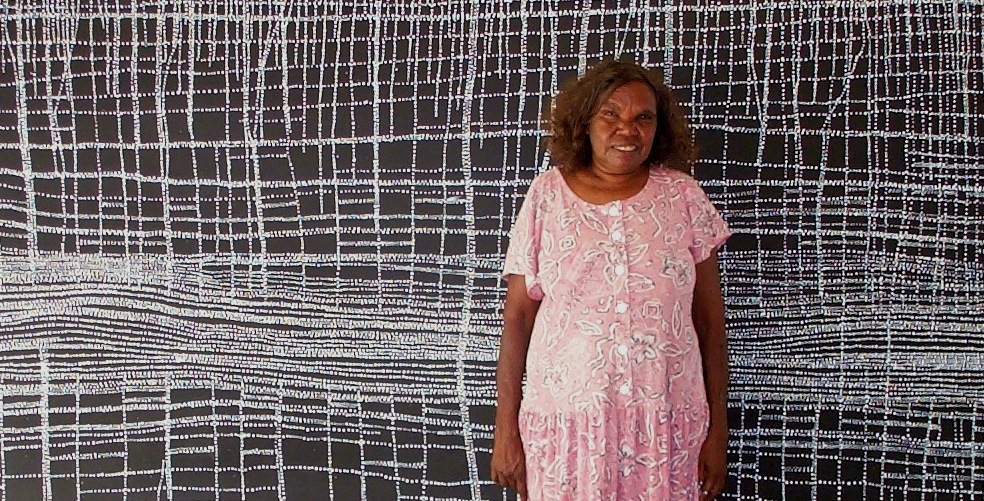
Colour Palettes of Dorothy Napangardi
During the course of her early career, Dorothy worked with a range of colour palettes. In the latter part of her career, she worked in black and white.
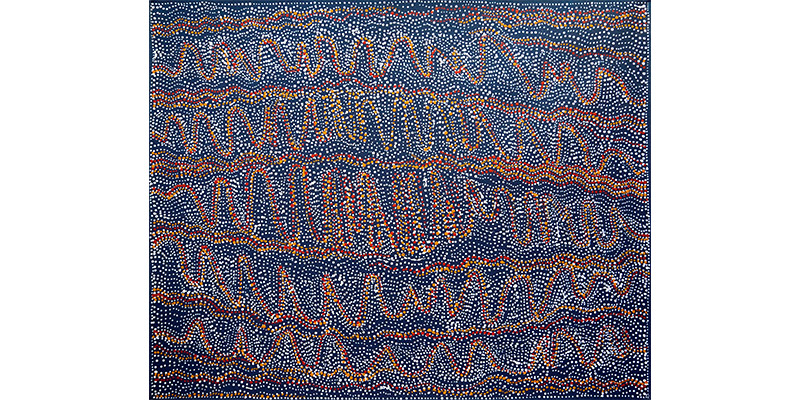

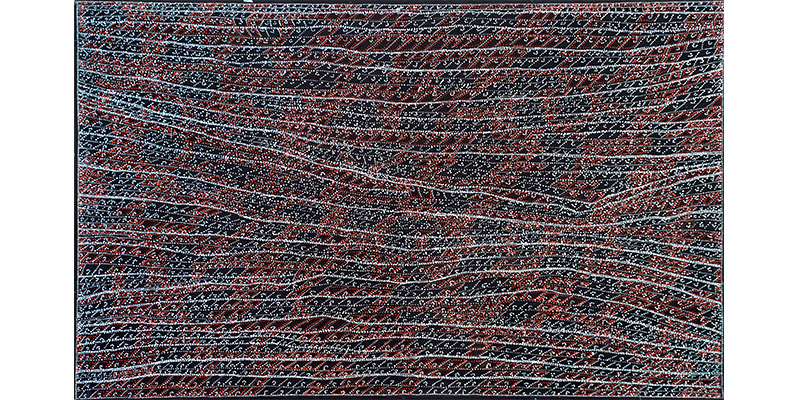





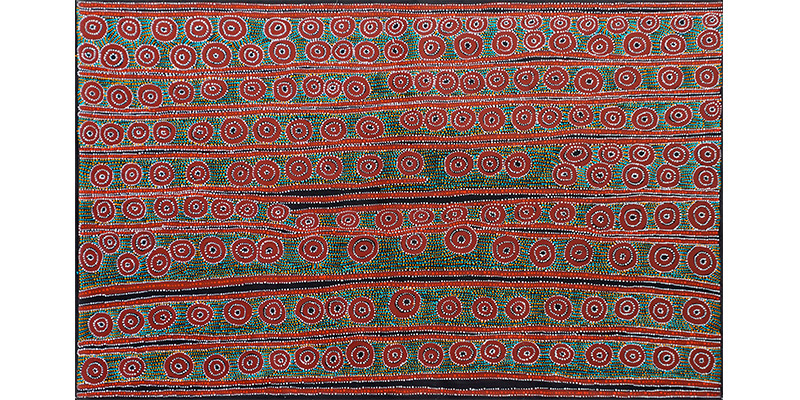

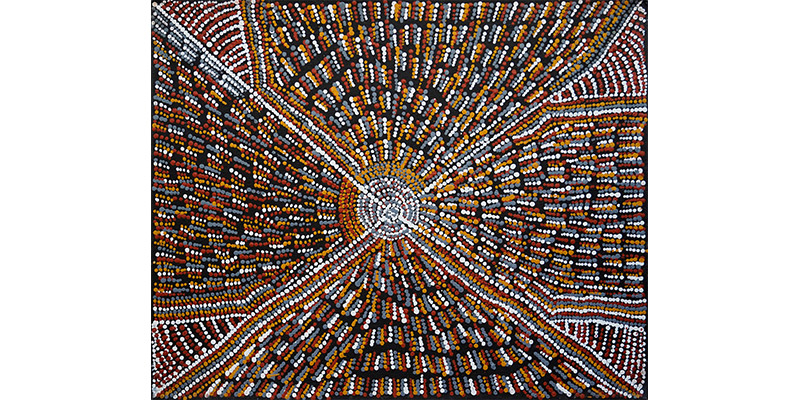

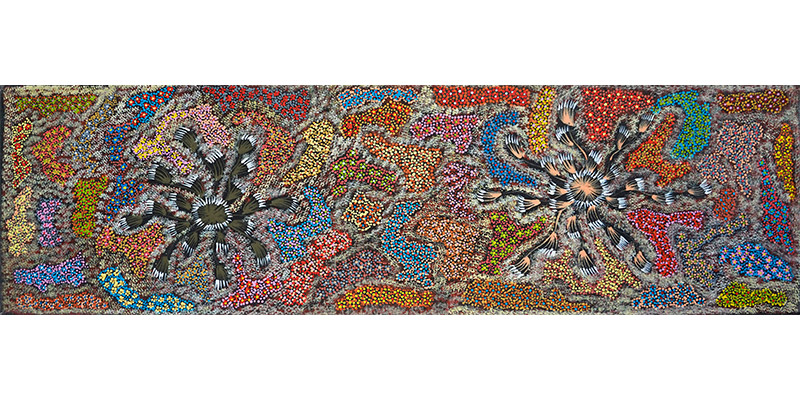

Artistic Legacy - Dorothy As A Leader
Dorothy's close friend and Manager Roslyn Premont reflects on Dorothy's artistic legacy.
I think Dorothy will be remembered as a leader in her field. I'd say this is why it's important that the history be told. Now you see a lot of beautiful paintings that are coming out. But it's a lot easier for younger artists to do this. When Dorothy did it, and at the time, nobody was doing this.
She was groundbreaking. She was right at the forefront of the movement. Dorothy is recognised internationally as an important Australian artist, not just an Australian Indigenous artist but as an important Australian artist.
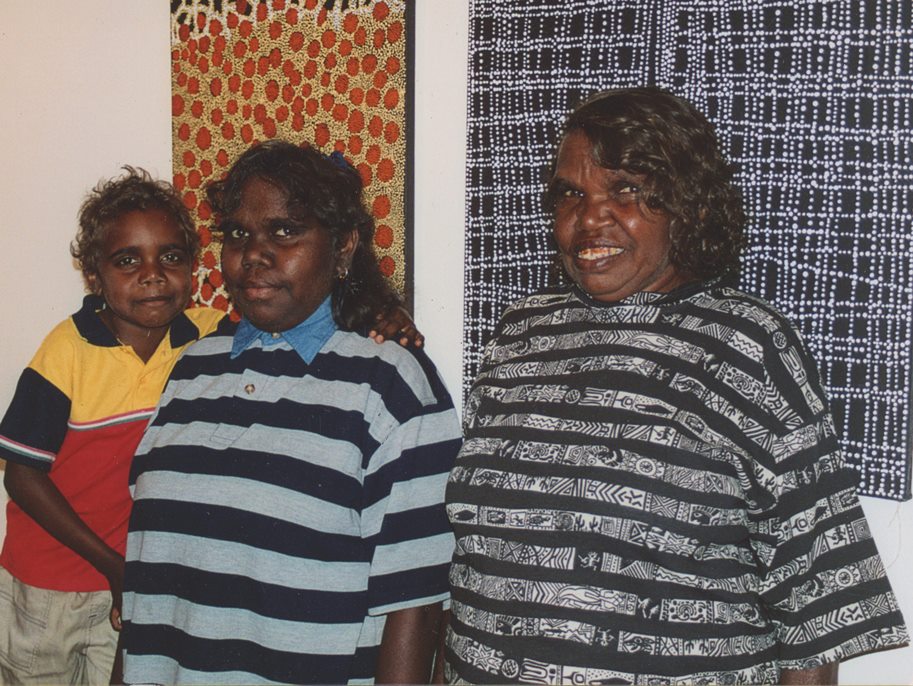
Dorothy's work is in the Metropolitan Museum of Art in New York. It's shown in museums and art galleries around the world, as well as exhibitions. She was the first to paint negative space, the way she did in black and white, without the iconography that we're used to seeing. That just didn't happen when she did it. So she is a groundbreaking, talented artist, a leader in the field.
After the Japingka exhibition, I'll be travelling to Belgium. At that next exhibition, Dorothy's work will be shown alongside Emily Kngwarreye. This is a very chic gallery, from a very dedicated collector, not curator, who doesn't normally show Aboriginal art. She shows leading artists from all around the world. This is her first Aboriginal art show, and she's chosen Dorothy, Emily, and probably Kathleen Petyarre as well. This is how big collectors around the world see her. They see Dorothy as being significant and they want to show other collectors a body of work from her.
Quick Links
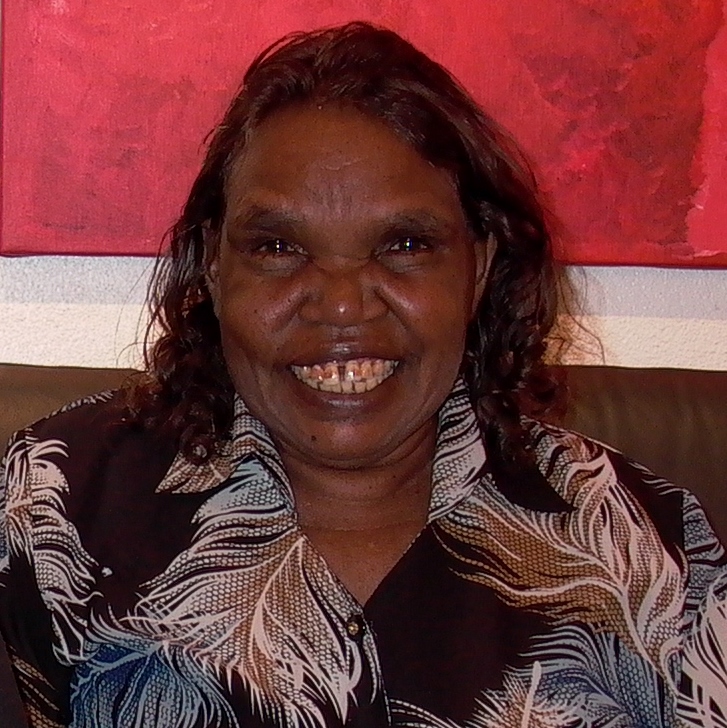
Exhibitions & Awards
Dorothy Napangardi Exhibitions, Prizes, Collections & Publications
Exhibitions
2019 La Biennale Paris, Arts d'Australie, Paris France
2019 Art Paris Art Fair, Arts d'Australie, Paris France
2018 Dorothy Napangardi | And They Danced Their Way Across Country; a retrospective: remembering the artist (20 October - 10 November 2018), Cooee Art Gallery in conjunction with Gallery Gondwana, Paddington NSW Australia
2018 The Limited Edition Works of Dorothy Napangardi, Online Exhibition, Gallery Gondwana, Alice
Springs NT Australia
2018 Walkabout: The Art of Dorothy Napangardi (commenced Sat May 5 2018 – March 7 2021), The
Seattle Art Museum (SAM), WA, USA
2018 Honouring Dorothy Napangardi, Online Exhibition, Gallery Gondwana, Alice Springs NT Australia
2017 Along the Lines (1 Feb-4 Mar), Group Exhibition, Fireworks Gallery, Newstead QLD Australia
2016-17 As Far As The Eye Can See (12 Nov 2016 – 15 Jan 2017), curated by Rilka Oakley in association with the Print Council of Australia’s 50th Anniversary celebrations, Blue Mountains Cultural Centre, Katoomba NSW Australia
2016 Etched in the Sun II (6 May – 5 June 2016), Nancy Sever Gallery, Braddon ACT Australia
2014 Melbourne Art Fair, Royal Exhibition Building, Melbourne VIC Australia
2014 Cross Over, Merricks House Art Gallery, Merricks VIC Australia
2013 Australia at the Royal Academy (21 Sep 2013 – 8 Dec 2013), Curator Kathleen Soriano and Director of
the National Gallery of Australia Ron Radford on ‘Australia’, Royal Academy of Arts, London, UK
2013 Basil Hall Editions Workshop Proof Exhibition (Sep 2013), Braidwood NSW Australia - include major works by Lena Nyadbi, Maringka Baker, Mandy Martin, Kumanjayi Cherel, Dorothy Napangardi, Regina Wilson and Garry Shead. The prints made in collaboration with Basil and printed by him and his team of printers in the last 5 years at the former BHE studio in Darwin
2013 Mina Mina Maranoa (31 Jan-30Mar), Joanne Currie Nalingu & Dorothy Napangardi, Fireworks
Gallery, Newstead QLD Australia
2012 18th Biennale of Sydney: all our relations, Sydney NSW Australia
2012 ‘Australian Contemporary Indigenous Art Now II’, Chiaroscuro Gallery, Santa Fe, USA
2012 ‘Ancestral Modern: Australian Aboriginal Art from the Kaplan & Levi Collection’, Seattle Art Museum,
Seattle, USA
2012 From the Bush II (Desert to Island), Group Exhibition featuring Dorothy Napangardi, Judy Watson
Napangardi & Yessie Mosby (Mar-Apr), Fireworks Gallery, Newstead QLD Australia
2011-12 ‘Spirit of the land’ (12 Nov 2011 – 12 Feb 2012), McClelland Gallery+sculpture Park, VIC; Hamilton Art Gallery, VIC; Araluen Art Centre, Alice Springs NT; Flinders University Art Museum, Adelaide SA; Benalla Art Gallery, VIC; Tweed River Art Gallery, NSW; Penrith Regional Gallery, NSW; Newcastle Region Art Gallery, NSW, Australia
2011 In Black & White, Japingka Gallery, Fremantle WA Australia
2010 All is Calm, FireWorks Gallery, Brisbane QLD Australia
2010 ‘Nexus – A collaboration in print from Central Australia and Fiji’,
New prints from Dorothy Napangardi, her daughter Julie Nangala Robinson, Mitjili Napanangka and
Rusiate Lali. The Gallery, Charles Darwin University campus, Darwin NT Australia
2009 "Lands of Enchantment: Australian Aboriginal Painting" (9 October 2009 – 10 January 2010 ) - presenting 26 masterworks by some of Australia’s best-known painters, including Emily Kame Kngwarreye, Dorothy Napangardi Robinson, Abie Loy Kemarre, Mitjili Napurrla, and Eubena Nampitjin, National Museum of Women in the Arts (NMWA), Washington D.C. USA
2009 The same river twice: part 2, ‘Dorothy Napangardi / John Reynolds’, Institute of Modern Art,
Brisbane QLD Australia
2008 ‘Custodians’ Collection of Etchings and Screenprints, Co Published by Basil Hall Editions, Nomad Art and Alison Kelly Gallery (Travelling exhibition), Australia
2008 ‘Melbourne Art Fair’, Royal Exhibition Building, Melbourne VIC Australia
2008 Women’s Law, Japingka Gallery, Fremantle WA Australia
2008 Etched in the sun: Prints made by Indigenous artists in collaboration with Basil Hall & printers 1997-
2007 (25 Sep 2008 – 2 Nov 2008), Drill Hall Gallery (The Australian National University, ANU), Acton
ACT Australia
2008 Dorothy Napangardi and Julie Nangala Robinson (July 18 – August 16, 2008), Gallery Gondwana, Sydney NSW Australia
2008 ‘Divas of the Desert’, Gallery Gondwana, Sydney and Alice Springs NT Australia
2008 ‘Handle with Care’, Adelaide Biennale, Art Gallery of South Australia, SA Australia
2008 Memories of Country (joint exhibition with Dorothy Napangardi, Gallery Gondwana, Sydney NSW Australia
2008 ‘LILLE ART FAIR’, Salon d’Art Contemporain, Grand Palais, Lille, France
2007 Country in Mind (Oct-Dec), Dorothy Napangardi & Yvonne Mills-Stanley, Fireworks Gallery, Newstead QLD Australia
2007 ‘The Best of the Best’, Framed Gallery, Darwin NT Australia
2007 ‘Divas of the Desert’, Gallery Gondwana, Sydney NSW and Alice Springs NT Australia
2007 Dorothy Napangardi Etchings and screenprints 2001-2006 (28 June – 31 July 2007), Northern
Editions, Darwin NT and Gallery Gondwana, Alice Springs NT Australia
2007 The Story of Australian Printmaking 1801-2005 (30 March – 3 June 2007), National Gallery of
Australia (NGA), Canberra ACT Australia
2006 ’Journey to Mina Mina’ – Solo Exhibition (Feb/Apr), Gallery Gondwana, Waterloo / Sydney NSW Australia
2006 Melbourne Art Fair, Melbourne VIC Australia
2006 ‘Dreaming Their Way’ – Australian Aboriginal Women Painters (30 June - 24 September 2006), National Museum of Women in the Arts, Washington, USA
2006 Painted Stories, Contemporary Paintings by Australian Aboriginal Women – (21 June 2006 – 1
September 2006), Embassy of Australia, Washington DC USA
2006 ‘Hosfelt Gallery New York Preview’, Hosfelt Gallery, New York, USA
2005-06 Dorothy Napangardi (3 December 2005 - 21 January 2006), Hosfelt Gallery, San Francisco, USA (in association with Gallery Gondwana, Australia)
2005 ‘Imagined Worlds – Willful Invention and the Printed Image 1470-2005’, AXA Gallery, New York, USA
2005 ‘Winter Group Show’, Crown Point Press, San Francisco, USA
2005 The Women’s Show (May 11-June 4, 2005), Vivien Anderson Gallery, Melbourne VIC Australia
2004 Mina Mina and Pirlinyanu (23 October – 5 December 2004), Holmes à Court Gallery (in association with Gallery Gondwana), Cowaramup WA Australia
2004 Pushing Boundaries; Contemporary Women's Art (9 November – 4 December 2004), Gallery
Gondwana, Danks Street, Waterloo / Sydney NSW Australia
2004 Melbourne Art Fair, Melbourne VIC Australia
2004 ‘Ngati Jinta – One Mother’, Gallery Gondwanaat the Depot Gallery, Sydney NSW Australia
2004 Dorothy Napangardi: Mina Mina Country (18 November – 13 December 2004), Crown Point Gallery, San Francisco, USA
2003 ‘Collectors Show’, Gallery Gondwana at The Depot Gallery, Sydney NSW Australia
2002-03 ‘Dancing Up Country: The Art of Dorothy Napangardi’ – Asialink, The University of Melbourne (in partnership with MCA, Sydney), Curator Vivienne Webb, Melbourne, VIC, Australia and touring Museum of Contemporary Art Australia Sydney (10 Dec 2002 – 9 Mar 2003), Vietnam Fine Arts Museum Hanoi (22 Apr 2003 – 3 May 2003), National Art Gallery Kuala Lumpur (12 May 2003 – 15Jun 2003)
2002-03 ‘Dancing Up Country: The Art of Dorothy Napangardi’ (10 December 2002 to 9 February 2003) –
Museum of Contemporary Art (MCA), Sydney NSW Australia
2002 ‘Kana-kurlangu’ Dorothy Napangardi – Gallery Gondwana at The Depot Gallery, Sydney NSW
2002 Melbourne Art Fair 2002, Melbourne VIC Australia
2002 Indecorous Abstraction – Contemporary Women Painters, Light Sq. Gallery
AIT ARTS, Adelaide SA Australia
2002 ‘Native Title Business – Contemporary Indigenous Art ‘National Travelling Exhibition, Gurang Land
Council (Aboriginal Corporation), QLD Australia
2002 ‘One Mother’, Dorothy Napangardi and Sabrina Nangala, Gallery Gondwana, Alice Springs NT Australia
2001 ‘Dorothy Napangardi’, New Paintings, Vivien Anderson Gallery, VIC Australia
2001 31st Alice Prize, Araluen Arts Centre, Alice Springs NT Australia
2001 ‘Masterwork’, Vivien Anderson Gallery, VIC Australia
2001 ‘18th National Aboriginal and Torres Strait Islander Art Award’, Darwin NT Australia - Dorothy won the coveted first prize with a black and white work entitled ‘Salt on Mina Mina’ (a work associated with the Women's Digging Stick Dreaming).
2001 ‘Mina Mina’, Solo, Dorothy Napangardi – Gallery Gondwana, Alice Springs NT Australia
2001 ‘Dreamtime: The Light and the Dark’, Sammlung Essl, Klosterneuburg, Vienna, Austria
2001 ‘Country After Rain’, Framed – The Darwin Gallery, Darwin NT Australia
2001 'alice.fitzroy@af', Alliance Francaise de Canberra and French Embassy, Canberra ACT Australia
2000-01 ‘The Art of Place Exhibition’, Australian Heritage Commission, Old Parliament House, Canberra ACT Australia
2000 ‘Melbourne Art Fair 2000’, Melbourne VIC Australia
2000 ‘Songlines: Walala Tjapaltjarri & Dorothy Napangardi’, Rebecca Hossack Gallery, London, UK
2000 ‘Dorothy Napangardi and Walala Tjapaltjarri, Adelaide Festival, Gallery Australis, SA Australia
2000 ‘17th National Aboriginal and Torres Strait Islander Art Award’, Darwin NT Australia
2000 ‘Recent Paintings by Dorothy Napangardi, Vivian Anderson Gallery, Melbourne VIC Australia
2000 ‘Dorothy Napangardi’, Hogarth Gallery, Sydney NSW Australia
2000 ‘5th National Indigenous Heritage Art Award’, Australian Heritage Commission, Canberra ACT Australia
1999 ‘Painting the Desert’, Alliance Francaise de Canberra and French Embassy, Canberra ACT Australia
1999 ‘The Redlands Westpac Art Prize’, Mosman Art Gallery, NSW Australia
1999 ‘My Country - Journey of our Ancestors’, Ancient Earth Indigenous Art, Cairns QLD Australia
1999 ‘16th National Aboriginal and Torres Strait Islander Award’, Darwin NT Australia
1999 Recent works by Dorothy Napangardi’, Chapman Gallery, Canberra ACT Australia
1999 ‘Recent works by Dorothy Napangardi and Walala Tjapaltjarri’, Vivian Anderson Gallery, Melbourne
VIC Australia
1999 ‘Treading Softly', Chapman Gallery, Canberra ACT Australia
1998 Northern Territory Art Award, Alice Springs NT Australia
1998 ‘Warlpiri Women’, Gallery Gondwana, Alice Springs NT Australia
1998 ‘Napangardi Dreaming - Ceremony and Song’, Hogarth Gallery, Sydney NSW Australia
1998 ‘15th National Aboriginal and Torres Strait Islander Art Award’, Darwin NT Australia
1991 ‘8th National Aboriginal Art Award’, Darwin NT Australia’, Darwin NT Australia - her winning work was a lyrical and evocative painting of the bush banana.
Collections
‘the Met’ (The Metropolitan Museum of Art), New York, USA
SAM (Seattle Art Museum), Seattle, Washington DC, USA
MCA Collection (Museum of Contemporary Art), Sydney NSW Australia
The Kaplan-Levi Collection, Seattle, USA Fine Arts Museums of San Francisco, USA National Gallery of Victoria, VIC Australia
National Gallery of Australia, Canberra ACT Australia Art Gallery of South Australia, SA Australia Queensland Museum, QLD Australia
Museum and Art Galleries of the Northern Territory, Darwin NT Australia
National 18th National Aboriginal and Torres Strait Islander Art Awards, Darwin NT Australia
The Kelton Foundation, Santa Monica, LA, USA The Kerry Stokes Collection, Perth WA Australia Musee des Confluences, Lyon, France
The Holmes a’ Court Collection, Perth WA Australia
Isibashi Foundation – The Bridgestone Museum, Tokyo, Japan
The LeWitt Collection, Chester, Connecticut, USA
The Australia Council Collection, Sydney NSW Australia
South Australian Festival Centre Foundation, Adelaide SA Australia
The Homesglen Institute of TAFE Collection, VIC Australia
The Erskine Collection, NSW Australia The Vroom Collection, The Netherlands The Kingston Collection, UK
Linden Museum, Stuttgart, Germany
Gallery Gondwana Collection, Alice Springs NT Australia
Araluen Art Centre Collection, Alice Springs NT Australia
Awards
2001 First Prize, ‘18th National Aboriginal and Torres Strait Islander Art Award’, Darwin NT Australia - Dorothy won the coveted first prize with a black and white work entitled ‘Salt on Mina Mina’ (a work associated with the Women's Digging Stick Dreaming)
1999 Highly Commended, 16th National Aboriginal and Torres Strait Islander Art Award, Darwin NT Australia
1998 Northern Territory Art Award, Alice Springs NT Australia
1991 Best Painting in European Media, ‘8th National Aboriginal Art Award’, Darwin NT Australia - her winning work was a lyrical and evocative painting of the bush banana.
Publications
2020 Dorothy Napangardi – Honouring and Remembering the art and life of, Roslyn Premont, Gallery
Gondwana, Alice Springs NT Australia, ISBN 978-0-6487650-0-4
2016 MCA Collection (Museum of Contemporary Art), Sydney NSW Australia
2012 Ancestral Modern: Australian Aboriginal Art (exhibition catalogue) Seattle Art Museum, USA ISBN 978-0-300-18003-9
2010 Spirit in the Land – McClelland Gallery+Sculpture Park, Langwarrin, VICT – Education Resource –
Primary and Secondary Schools
2009 50 Most Collectable Artists, Australian Art Collector magazine
2009 Relationscapes – Movement, Art, Philosophy by Erin Manning , The MIT Pres, Cambridge, Massachusetts, London, England, ISBN 978-0-262-13490-3
2008 Beyond Sacred – Recent paintings from Australia’s remote Aboriginal communities.
The Collection of Colin and Elizabeth Laverty.
Published by Hardie Grant Books, 85 High Street, Prahran, VIC, Australia 3181
2008 New Beginnings – Classic Paintings from the Corrigan Collection of 21st Century Aboriginal Art
By Emily McCulloch Childs, Ross Gibson.
Published by McCulloch & McCulloch ISBN 9780980449440
2006 Dreaming Their Way – Australian Aboriginal Women Painters, National Museum of Women in the
Arts, Washington, USA
Published by Scarla Publishers Ltd, Northburgh House, London, UK ISBN 1 85759 442 8
2006 Magical Secrets about Thinking Creatively – The Art of Etching and the Truth of Life, Kathan Brown – Crown Point Press.
Published by AXA Gallery, Distributed by International Print Center, New York, USA
ISBN 3 7913 3654 1
2005 Imagined Worlds – Willful Invention and the Printed Image 1470-2005
Published by AXA Gallery, Distributed by International Print Center, New York, USA ISBN 0 9774239 0 5
2004 Overview – Making Prints with Dorothy Napangardi, Crown Point Press, Newsletter, November 2004
2004 Our Country, Our Art – Welcome to the Art of Contemporary Australian Aboriginal Artists
Published by POSCO Art Museum, Korea ISBN 0 2737 3283
2002 Dancing up Country – The Art of Dorothy Napangardi
Published by Museum of Contemporary Art, Circular Quay, Sydney, NSW, Australia
Bibliography. ISBN 1 875632 82 4
Other Projects
2016 “Eight Paintings by Leading Aboriginal Artists Enhance The Met’s Contemporary Art Holdings through
Promised Gift from Robert Kaplan and Margaret Levi”, The Met, New York, USA (14 July 2016)
– Dorothy Napangardi is one of the eight artists: Dorothy Napangardi (born Yuendumu, ca. 1950–
2013), Karntakurlangu Jukurrpa, 2002. Dorothy Napangardi enrolled in the Institute for Aboriginal
Development in Papunya in 1990 and learned to use western painting materials to create intricate, brilliantly colored representations of bush vegetation. Karntakurlangu Jukurrpa (2002) exemplifies her highly original and experimental mature work imagery to abstract compositions in a reduced palette.
2013 The 50th Edition of the Ermenegildo Zegna Wool Tropies held at the Royal Hall of Industries, Moore Park Australia (23nd April 2013) – featuring the pied-de-poule fabric from Australian wool produced by Lanificio in the 60s and currently re-interpreted in Trofeo Natural Comfort - models and actors including Chris Hemsworth (Australian actor) and Daniel Henney (Korean actor) wore tie and pochette made from printed fabrics inspired by aboriginal “dot art” paintings, realized by artist Dorothy Napangardi; a tribute to the Australian Aboriginal culture.
2009 Almanac: The Gift of Ann Lewis AO, MCA - 8 December 2009 to 18 April 2010. (Touring Australian and regional galleries until 2013). The Gift includes a range of artworks from different times and locations, including early works by Rosalie Gascoigne from the mid 1970s to paintings by Aboriginal artists from remote communities and photographic series by artists such as Rosemary Laing and Jon Lewis. Other artists included in the collection are Hany Armanious, Mikala Dwyer, Sally Gabori, Emily Kame Kngwarreye, Rosella Namok, Dorothy Napangardi Mirdidingkingathi Juwarnda, Robert Rauschenberg, Neil Roberts, Ricky Swallow, Judy Watson, Louise Weaver and Anne Zahalka.
Read More
Subscribe To Our Email Newsletter
Receive notifications and news about exhibitions and artists.
Quick Links
